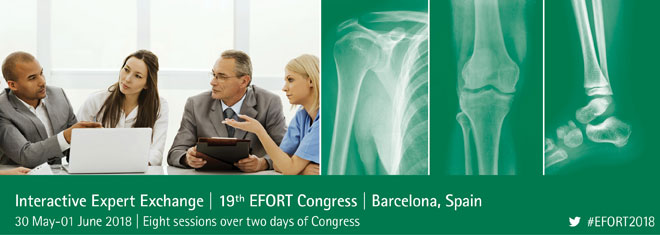Session at 19th EFORT Congress helps surgeons choose the best procedure for forefoot pathologies

The Interactive Expert Exchange session entitled “Forefoot pathologies: When to do open and when to do percutaneous?” scheduled for the upcoming congress in Barcelona will allow attendees focused on foot and ankle pathologies to develop or reject their position on minimally invasive techniques or traditional surgery for treatment of hallux valgus and/or Civinini-Morton syndrome.
Indeed, by extensively discussing all the medical characteristics, pros and cons, and expected results of each procedure with experts making this choice on a daily basis, participants will be able to overcome any possible doubt when the type of treatment needs to be defined. The direct and closed exchange ensured by the high interactivity of this session format will lead practitioners from the audience to challenge each indication presented by the faculty panel and conclude with a common rationale and strategy for the decision-making.
Forefoot pathologies are common osteoarticular, neurologic and functional diseases, mainly observed in women, and have received a lot of interest from the orthopaedic community in the last 20 years. An important development of the surgical techniques devoted to cure these painful conditions has been observed worldwide and new procedures have been introduced as common treatments. The most widely diagnosed foot pathologies are indisputably hallux valgus and the Civinini-Morton syndrome.
For a long time, surgery for these conditions was invariably performed with large incisions. The skin wounds of the lower limb usually resolve well and disappear almost completely in the first year following the operation. However, patients still wish to have the smallest scar possible, especially when learning that the less significant the incision is, the faster the postoperative recovery is. Minimally invasive surgery (MIS) and percutaneous surgery were popular approaches in the United States during the 1960s, but were largely abandoned in the following decades due to multiple complications and frequent recurrence of the disease. Nowadays, MIS techniques are gaining increased interest among the orthopaedic community because of the availability of modern surgical devices, intraoperative fluoroscopy and adequate postoperative regimens.
Forefoot Pathologies: When to Do Open and When to Do Percutaneous?
Thursday 31 May 2018 | 10:00 – 12:15
Introduction & Conclusions
Marino Delmi (Switzerland)
Questions & Presentations
- Forefoot MIS And Percutaneous Surgery: The Evidence – Marino Delmi (Switzerland)
- Civinini-Morton Syndrome: Less Problem with Percutaneous Surgery – Eduard Rabat (Spain)
- Civinini-Morton Syndrome: Open Surgery is More Predictable and Efficient – Pierre Maldague (Belgium)
- Hallux Valgus: Why MIS and Percutaneous? – David Redfern (United Kingdom)
- Hallux Valgus: Why Open? – Jean-Luc Besse (France)
Discussion on Clinical Cases
Thanos Badekas (Greece) & Piotr Chomicki-Bindas (Poland)
As medical evidence in the forefoot surgical field is still at its beginning and the learning curve is long and difficult, the MIS and percutaneous techniques still need to scientifically prove efficacy and low morbidity before being widely disseminated as the preferred choice among foot and ankle surgeons or used as standard procedures. However, it is clear these techniques will stay part of the instrumentation used to cure forefoot pathologies and the decision to use them will rely on the medical background of a specific patient and the personal choice of each surgeon.
To better guide the treatment choice, this session will address the preoperative considerations, as well as all the latest data regarding both minimally invasive and open operative techniques. The multinational panel of experts will share the best tips and tricks to avoid complications and ensure the best outcome for the patient.

Interactive Expert Exchanges (IEEs) are paying sessions and pre-registration is mandatory on a first-come, first-serve basis (maximum of 200 participants). Only participants with a full registration for the congress can attend the IEE sessions. All details to sign-up will be available on our registration platform as of January 2018. Visit our Barcelona congress website regularly.
- For more information:
- 19th EFORT Congress in Barcelona | 30 May to 1 June 2018
- Interactive Expert Exchange sessions

